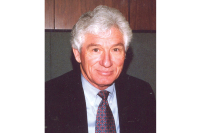Stepping down: Aumen’s departure marks end of an era for Haywood TDA
 Editor’s note: Alice Aumen has been a major voice in Haywood’s tourism landscape for more than half a century — as a founder of Cataloochee Ski Area, operator of the third-generation family-run Cataloochee Ranch and a leader in the Maggie Valley Chamber of Commerce.
Editor’s note: Alice Aumen has been a major voice in Haywood’s tourism landscape for more than half a century — as a founder of Cataloochee Ski Area, operator of the third-generation family-run Cataloochee Ranch and a leader in the Maggie Valley Chamber of Commerce.
But one of Aumen’s biggest marks has been with the Haywood County Tourism Development Authority. She helped start the county’s official tourism arm 30 years ago and has served on its board for much of the past three decades.
As Aumen steps down from her long tenure on the tourism authority this month, The Smoky Mountain News asked her to reflect on the trials and triumphs she’s witnessed in the tourism industry.
It’s on the top rung of the mountain’s economy now, but not too long ago, tourism was on the outside looking in, relegated to the fringes of the mainstream power circles.
“If you mentioned tourism, they would pooh-pooh it as some kind of backwoods thing,” said Alice Aumen, who has been plying the tourist trade in Haywood County for more than 50 years. “That is the single largest difference that I have seen — that tourism is a major industry and is recognized as that.”
In reality, tourism has been a major industry in the mountains for decades. But it didn’t have the same respect or recognition. It was a red-headed step child, a second-class citizen, the low man on the totem pole.
Related Items
The larger business community just didn’t grasp the true footprint of tourism. It goes beyond the standard multiplier effect. Today’s tourist is tomorrow’s entrepreneur or home buyer, Aumen explained.
“People who come here on vacation first will then come back and invest in a home or start a business. They always visited here first,” Aumen said. “That was a hard message to get across.”
It’s a widely-understood paradigm now, but not always.
“Sometimes you really had to drag them kicking and screaming to that realization,” Aumen said.
Aumen was born into tourism, raised by one of the region’s earliest pioneers in the vacation trade. Her parents owned and ran Cataloochee Ranch, a rustic mountain-top dude ranch in Maggie Valley. She grew up watching well-heeled travelers from New York to Savannah make the journey to her parent’s Smoky Mountain retreat.
Aumen entered the front lines of tourism herself in 1961, lured by the new-fangled venture known as Cataloochee Ski Area. Snowmaking was brand-new technology, and the family’s high-elevation land seemed like a perfect candidate for a ski mountain — the first in North Carolina, in fact.
“That was so exciting and so new. It was hard, hard work but so much fun,” said Aumen. By the 1970s, she had picked up the reins of Cataloochee Ranch.
By the boot straps
If Aumen had to point to a single turning point in the rise of prominence by the Haywood’s tourism industry, it would be the creation of the Haywood County Tourism Development Authority 30 years ago.
The idea was novel but simple. A self-imposed tax on overnight lodging would raise money for tourism marketing, and in turn, hopefully, be used to lure more tourists.
The tourism magnates of Haywood championed the idea together, lobbying in Raleigh for the authority to impose a so-called “bed tax” on motels, hotels, resorts, inns and the like. Haywood jumped on the same train as Buncombe and Mecklenburg counties—which were also seeking state approval for their own tourism authorities — and became one of the first three counties in the state to get into the game.
“It was really uncharted territory,” Aumen said. “We had some really forward-looking people.”
There was surprisingly little controversy or opposition to the tax, Aumen recalls.
“We just recognized the value of having any funds to do promotion with,” Aumen said.
When leaders in the tourism industry agreed to start taxing their own businesses, buying clout wasn’t the goal. They just wanted a revenue stream to help promote Haywood County as a destination — and in turn bolster their trade. But it seemed to help tourism claim its rightful seat at the table.
“The occupancy tax had a lot to do with it because all of a sudden there were dollars,” Aumen said. “Look at all the people lining up now to get a share of it.”
Masters of their own destiny
The tax tacked on to tourists’ hotel bill was seen as the ticket to self-determination. Deciding what to do with the money was another story, however.
“Whenever you have money, there is going to be friction. And all of a sudden you had this money coming in,” Aumen said.
The tug of war over the tourism dollars has waxed and waned over the past 30 years, but it has always been there — one of the constants through the decades.
Should marketing promote skiing, motorcycling, shopping, festivals or golfing? Should it tout bed and breakfasts, resorts, roadside motels or rental cabins?
But the most relentless quarrel in Haywood County has been geographic: namely Maggie Valley versus Waynesville, with Canton making noise around the edges.
Thirty years ago, Maggie Valley was solidly in the driver’s seat of the tourism authority. When Ghost Town was in its heyday and Cataloochee Ski Area bringing in winter visitors, it raked in a huge percentage of the room tax. But the playing field has slowly been evening out. Waynesville has become a tourist typhoon thanks primarily to its downtown renaissance, while Maggie’s appeal has declined with the closing of Ghost Town.
Still, the philosophical underpinning of the tourism tax was that a rising tide would lift all boats. Rather than competing against each other, the industry joined forces, collectively marketing the area as a destination in hopes of benefiting all.
Occasionally though, people would seek a seat on the tourism board out of self-interest and attempt to steer the tourism dollars for their own gain or pet project.
Some had a tit-for-tat obsession, exacerbating the inevitable turf skirmishes into outright battles.
“Only a few had the mindset, ‘Well, someone is going to get more than me,’” Aumen said.
And some were simply disruptive.
“You had grandstanders,” Aumen said.
But the past five years have been a period of relative calm and cooperation on the board. That’s not to say everyone in the tourism industry has been completely happy with how the tourism board divvies up the money — for example, the tourism authority caught flack for cutting chamber of commerce visitors centers and opening its own visitor centers instead.
But among the board itself, the factionalism and infighting that marked the previous decade, often landing the tourism authority in an unflattering media spotlight, has subsided. But that’s not a coincidence.
The tug of war over tourism dollars was placated by increasing the tax from 3 to 4 percent several years ago. As hoped, a bigger pot of money to go around miraculously abated some of the money fights.
An attempt to raise the room tax again — from 4 to 6 percent — didn’t go over quite as well last year, however. The extra stream of revenue was going to be earmarked for tourism attractions and venues.
Despite wide support among the tourism industry and local government leaders, some mom-and-pop motel owners in Maggie with anti-tax sentiments bent the ear of Republican state legislators and derailed the bill.
Aumen said it didn’t make sense. The mom-and-pop motels in Maggie are struggling due to shuttered or severely dated tourist attractions. They stood to gain the most, yet defeated it.
“That’s why this extra 2 percent is just crucial to the economic scene. They really need product development,” Aumen said.
The state legislators told the tourism board to find a way to get the naysayers on board before they’d support it. Aumen thought back to the movement 30 years ago when the initial tax was proposed. Despite being a new concept, it wasn’t all that hard to get through.
“I don’t remember us having to trot around and do this major campaign,” Aumen said. “There wasn’t all this concern about every constituent having to agree.”
Money where their mouth is
The aspirations of Aumen and others who founded the tourism authority in 1983 were modest to say the least.
“We thought ‘Gosh if it would raise $20,000, wow,’” Aumen recalled.
And their wish list wasn’t very deep: a vacation guide magazine and an ad in Southern Living.
The tourism authority had no staff in those early years — figuring out what ads with what messages to run in what magazines was up to an all-volunteer board made up of people in the local tourism industry.
“At first advertising was by the seat of your pants,” Aumen said.
But by the mid-1990s, the TDA board realized it was time to hire an executive director.
“Hiring a director was a major turning point,” Aumen said. “The money had gotten significant enough, and the approach to advertising and promotion was shifting so fast.”
Now, the tourism tax brings in almost $1 million. The TDA has a staff of four, plus a host of contracts with specialized firms in various advertising and marketing fields.
Today’s tourism strategy still includes that stalwart of any tourism arm — the visitors guide. And magazine ads are still ubiquitous, too.
But the comprehensive portfolio goes to creative branding campaigns, promotional videos, visitor center operations, festival and event underwriting, online marketing. The tourism authority has an official to bill Haywood as a movie filming location.
The newest branding campaign by the tourism authority promotes Haywood as an authentic travel destination. Homegrown in Haywood plays up traditional music, crafts, food, drink, culture and outdoor recreation.
Compared to those early years, when marketing had more of a scatter-gun approach, advertising messages and campaigns today rely heavily on studies and polling to ensure effectiveness.
“Research is absolutely crucial,” Aumen said.
Visitor demographics — what appeals to them, why they visit Haywood and where they come here from — have been studied extensively.
And the tourism authority learned something.
“The number one draw is scenery. I don’t think we recognized it until we did the research. You have a responsibility and challenge to preserve that and enhance it wherever possible,” Aumen said.
In hindsight, it should have been obvious that the mountains themselves are the number one attraction — just like the beach is the top draw when visiting the beach. But that asset wasn’t always at the forefront in the early years of the tourism authority.
“We were focused more on things to do, not just coming to sit and enjoy the natural beauty,” Aumen said.
Aumen credits Lynn Collins, the executive director of the tourism authority for much of the past decade, with bringing a research-based approach to everything the tourism authority now does.
“Where you are getting the bang for your buck?” Aumen said.
The research has revealed a major challenge ahead, one the tourism industry suspected anecdotally that has now been crystallized. Retirees and empty-nesters comprise a disproportionate share of travelers to the mountains.
“I really think we need to renew the enticement for families. That’s your future generation of customers,” Aumen said.
Kids who come to the mountains on family vacations today will come back with their own kids one day — something Aumen sees play out at Cataloochee Ranch.
“We have fourth generations coming now,” Aumen said.
Despite Aumen’s tenure on the tourism authority — 30 years minus a short hiatus here and there — she was never stuck in the past.
“She was definitely an agent for change,” said Lynn Collins, the executive director of the tourism authority. “She was always at the forefront whenever we talked about wanting to do something new or different.”
“That’s just in my nature,” Aumen said.









